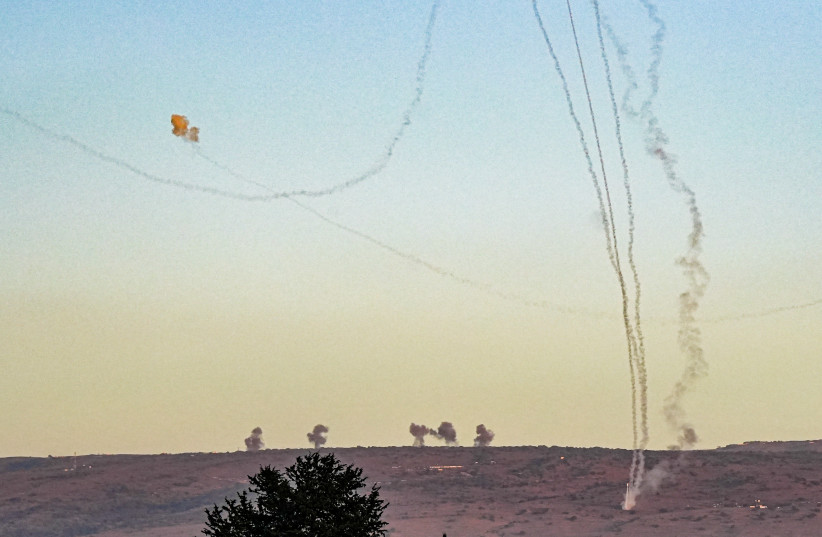Hezbollah on Monday fired dozens of rockets toward the Golan in a significant departure from its general focus on the northern Galilee.
The Lebanese terrorist group said it was aiming for an IDF Golan base in retaliation for Israeli strikes near the city of Baalbek, which were themselves unusually deep strikes into Lebanon’s territory.
Baalbek is around 100 kilometers away from the Israeli border and is in Lebanon’s northeast, whereas most IDF attacks to date have been focused only on southern Lebanon, or on Beirut, which is still much further south than Baalbek.
No injuries reported
There were no reports of injuries from what Hezbollah said was a 60-rocket barrage.
The IDF did not say how many rockets were fired, but the Home Front Command only recorded 20 rocket sirens, appearing to ignore much of the Golan rocket fire as not dangerous during this round.

Occasionally, Iranian-affiliated militias from Syria have fired small numbers of rockets on the Golan, but nothing near Monday’s volume from Hezbollah; the Golan has mostly remained quiet recently.
Continuing the rounds of retaliation, the IDF later said it had killed senior Hezbollah official Hassan Hussein Salami in an airstrike on southern Lebanon.
Salami, whose rank is the equivalent to that of a brigade commander, was hit on the way to the southern Lebanon village of Majadel. This was one of the rare cases where the IDF intentionally took credit for the assassination.
According to the IDF, Salami commanded one of Hezbollah’s regional units, including managing attacks on IDF troops and Israeli communities in northern Israel, especially Kiryat Shmona.
Further, they said Salami was involved in directing the Hezbollah attack on an IDF base – Brigade 769.
The IDF appeared to take public credit due to Salami’s role in attacks on IDF bases, something the IDF has tolerated less than Hezbollah attacks on empty evacuated villages.
In contrast, the IDF usually does not take credit for assassinations in Lebanon, nor does it for most specific operations in Syria – though it admits to having attacked Iranian-affiliated targets in Syria thousands of times in recent years.
According to Reuters, at least two simultaneous strikes hit around Lebanon’s city of Baalbek, two security sources said.
An Israeli man was injured by a barrage of rockets fired at Moshav Shtula in the Galilee by Hezbollah on Monday.
Earlier on Monday, Hezbollah said it had shot down an Israeli Hermes 450 drone over Lebanese territory with a surface-to-air missile, the second time it has announced a downing of this type of unmanned aerial vehicle (UAV).
The Hermes 450 is a multi-payload drone made by Elbit Systems, an Israel-based weapons manufacturer.
The Israeli military stated earlier on Monday that two missile launches had targeted an Israeli Air Force UAV operating over Lebanon. The first, it said, was intercepted by Israel’s David’s Sling aerial defense system, but the drone “fell inside Lebanese territory” after the second missile attack.
“The David’s Sling aerial defense system intercepted a surface-to-air missile that was fired toward an Israeli Air Force UAV operating in Lebanon,” the IDF said in a statement. “Following the launch of the interceptor, sirens were sounded in the area of Alon Tavor in northern Israel.
No injuries were reported.
A short while after, an additional missile launch toward the UAV was identified and the UAV fell inside Lebanese territory.
The timing of the IDF’s decision to attack deeper into Lebanese territory seemed to come as a response to Hezbollah’s shooting down of the IDF drone.
Meanwhile, Defense Minister Yoav Gallant on Monday said that the evacuated northern residents will not return to their cities and homes before the hostages held by Hamas were returned.
In a meeting with hostage’ families, he reassured them that Israel was doing everything both militarily and diplomatically to bring back the around 100 living hostages, and the 30-plus bodies of hostages who were killed.
Although his formulation that northern residents would need to wait to return home until the hostages are released was in some ways not surprising. This was also a more explicit admission than usual that it will likely be months before the threat from Hezbollah is neutralized, even if a temporary ceasefire with Hamas is reached.
Hezbollah has said that it will cease attacking Israel the moment a ceasefire is reached with Hamas that would prevent Israel from launching new military activities within Gaza.
However, Gallant has consistently reiterated that the IDF will continue to attack Hezbollah until all of its forces were pushed back from the border with Israel all the way to an approximate point north of the Litani River.
Since even the current possible hostage deal describes an initial period of 45 days followed by another length of time spanning into months until a full hostage exchange is completed, this could easily take the continued evacuation of northern residents into the summer months.
Possibly not incidentally, on Sunday the government extended special rights for northern evacuees until July 7.
In the South, IDF Division 162, along with the Nahal Brigade and engineering forces, unearthed an underground tunnel network that connects the north and south of the Gaza Strip, the military announced on Monday.
The underground routes run for some 10 km. and pass under a hospital and a university.
After gaining operational control of the network, soldiers examined and destroyed large portions of it.
This was not the first such north-south extended Gaza tunnel, but its discovery and destruction is another sign of the gradual progress of the IDF in taking apart Hamas’s tunnel infrastructure.
Fully destroying that infrastructure is expected to take years.
Reuters contributed to this report.
